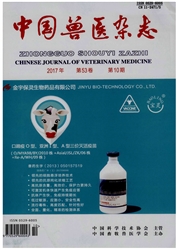

 中文摘要:
中文摘要:
本研究对2007年~2010年我国H9N2亚型禽流感病毒分离株的鸡胚平均死亡时间(MDT)进行分析,发现自2008年下半年来分离的H9N2亚型禽流感病毒对鸡胚的致病性有增强的趋势,在此基础上,选择MDT在60.5~96.3h之间的9株病毒,比较其对SPF鸡的致病力。结果表明,对鸡胚致病性强的毒株,对SPF鸡的致病性也较强,能引起气管、肺、十二指肠、肾和脑等多器官的系统性感染,而且病毒在各组织器官的复制能力与致病性呈正相关。在感染SPF鸡后,所有毒株均呈现不同程度的排毒,而致病力较强毒株的感染组,排毒的比例更高,排毒时间也更长。这些数据表明,H9N2病毒在进化过程中,致病力发生了一定的变化,新近出现了一些对鸡致病力增强的毒株,这提示我们必须重视对H9N2病毒进化和变异的监测,加强对H9N2病毒的防榨.
 英文摘要:
英文摘要:
During the surveillance of H9N2 subtype influenza viruses isolated between 20,07 to 2010, we found that the HgN2 viruses isolated after 2008 displayed higher virulence to embryonated eggs through the analysis,ofmean death time (MDT). So, nine isolates with different MDT between 60.5 and 96.3 hours were selected to study their pathogenicity in Chickens, and the results showed that the pathogenicity was consistent with the MDT.The virus with higher virulence in embryonated eggs also showed higher pathogenicity in chickens, and caused systemic infection. Furthermore, the period of shedding of infectious challenge virus was longer, in the higher virulence virus infected group. All the data indicated that the virulence of some recently epidemic H9N2 viruses was enhanced, which suggested that the genetic and pathogenic variation of H9N2 viruses should be closely monitored.
 同期刊论文项目
同期刊论文项目
 同项目期刊论文
同项目期刊论文
 期刊信息
期刊信息
